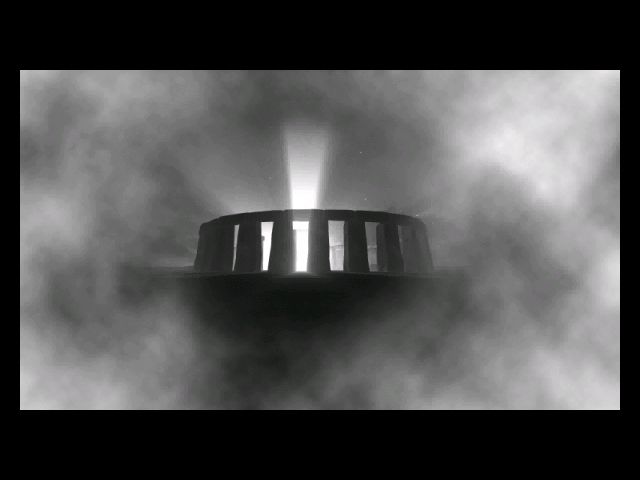Retro Replay Review
Gameplay
Drowned God: Conspiracy of the Ages centers on exploration and logic puzzles that drive both the narrative and the player’s sense of discovery. Players navigate through pre-rendered environments, clicking hotspots to move between “slides” and examine objects. This tile‐based movement system evokes the hallmark style of mid-’90s adventure titles, demanding patience and careful observation rather than fast reflexes.
(HEY YOU!! We hope you enjoy! We try not to run ads. So basically, this is a very expensive hobby running this site. Please consider joining us for updates, forums, and more. Network w/ us to make some cash or friends while retro gaming, and you can win some free retro games for posting. Okay, carry on 👍)
The heart of the experience lies in its variety of puzzles. From symbolic rod-and-ring challenges to cryptic cipher grids inspired by the game’s occult leanings, each brainteaser is designed to feel like uncovering a hidden chapter of an ancient conspiracy. While some puzzles draw clear inspiration from Myst’s environmental riddles, others introduce original mechanics—such as aligning sacred artifacts or reconstructing fractal mosaics—that reward players who take meticulous notes and explore every inch of their surroundings.
Interaction can sometimes feel finicky. Hotspots are not always obvious, and some solutions require pixel‐perfect clicking or backtracking through previously visited scenes. For modern players accustomed to highlighted interactives, this can result in occasional frustration. However, fans of classic point-and-click adventures will appreciate that Drowned God stays true to the era’s ethos—every object could be vital, and success hinges on thoughtful experimentation.
Another notable gameplay element is the time-and-space travel device. As players gather the four alien artifacts (the Ark of the Covenant, the Philosopher’s Stone, the Rod of Osiris, and the Holy Grail), they unlock portals to alternate dimensions. Each dimension presents unique environmental puzzles and hidden lore tablets, encouraging multiple revisits and layered problem-solving. The result is a pacing that ramps up intrigue with each new location, rewarding curiosity and methodical play.
Graphics
Graphically, Drowned God is a snapshot of its time. The game relies on pre-rendered, high-resolution backgrounds that depict surreal landscapes blending Egyptian motifs, medieval architecture, and science-fiction elements. These visuals establish a haunting, otherworldly ambiance well suited to the game’s conspiracy-laden plot.
Character and artifact models appear as full-motion video sequences, giving players short bursts of animation when interacting with NPCs or discovering crucial items. While these FMV inserts can feel dated by today’s standards—due to low frame rates and grainy compression—they still carry a certain retro charm. They underscore the mid-’90s ambition to merge cinematic storytelling with interactive gameplay.
Color palettes shift dramatically between locations: the sands of an alien desert glow with ominous reds, while a subterranean Templar vault is lit by flickering torchlight and bathed in cool blues. This contrast not only enhances mood but also serves as a visual cue that helps players remember puzzle layouts and important landmarks during backtracking.
It’s worth noting that modern displays can accentuate some of the game’s texturing limitations. Close-ups of artifacts or environmental details may appear blurrier than contemporary titles. However, the art direction remains commendable—each scene feels purposefully designed to immerse you in a labyrinth of conspiracies, where every shadow hints at a hidden truth waiting to be unearthed.
Story
At its core, Drowned God weaves a labyrinthine narrative that posits humanity as the creation of god-like aliens who have guided our evolution through powerful artifacts. The premise ties together legendary relics—the Ark of the Covenant, the Philosopher’s Stone, the Rod of Osiris, and the Holy Grail—suggesting they hold the keys to unlocking a profound cosmic conspiracy. This sprawling mythology taps into Templar legends, Illuminati lore, and esoteric symbology in equal measure.
Players assume the role of an unnamed protagonist thrust into a multidimensional chase. Sent through time and alternate realities, you pursue clues that link historical conspiracies to an alien oversight program. Dialogue snippets and collectible lore entries flesh out a story that refuses to stay grounded in one era, shifting from Renaissance catacombs to sci-fi interludes with startling fluidity.
The pacing of the narrative hinges on puzzle completion. Each artifact you retrieve reveals a fresh layer of the overarching plot, with voiced narration and text logs bridging between locations. While some players might find the exposition heavy—occasionally pausing the action for lengthy monologues—dedicated conspiracy buffs will relish piecing together the game’s intricate web of theories.
One of the story’s strengths lies in its refusal to spoon-feed answers. Many plot points remain tantalizingly ambiguous, encouraging players to form their own hypotheses about the true nature of the “Drowned God.” By the end, you’re left with as many questions as answers, a narrative choice that underscores the title’s central theme: in a cosmos of hidden manipulators, the line between fact and myth is forever blurred.
Overall Experience
Drowned God: Conspiracy of the Ages is a must-try for fans of retro adventure games and conspiracy narratives. Its blend of intricate puzzles, atmospheric visuals, and ambitious storyline sets it apart from more straightforward point-and-click fare. If you enjoy deconstructing mythologies and solving esoteric riddles, this title delivers a uniquely cerebral journey.
Expect a deliberate, methodical pace. The game rewards careful observation and note-taking, and progress can feel slow if you’re prone to skipping details. Yet, each puzzle solved brings a gratifying sense of unraveling a grand cosmic secret—aptly aligning with the game’s central conceit that hidden powers shape our reality.
While some technical aspects show their age—particularly the FMV quality and pixel-hunt elements—the immersive art direction and rich thematic content compensate for outdated mechanics. Modern players willing to overlook occasional interface friction will find themselves drawn into an engaging, conspiracy-laden odyssey.
In summary, Drowned God offers a distinct blend of mystery, exploration, and lore-driven puzzles that will especially appeal to those with an appetite for occult history and alien conspiracies. Though it demands patience and a willingness to navigate dated design choices, the reward is an unforgettable trip through time, myth, and the darker undercurrents of human civilization.
 Retro Replay Retro Replay gaming reviews, news, emulation, geek stuff and more!
Retro Replay Retro Replay gaming reviews, news, emulation, geek stuff and more!









Reviews
There are no reviews yet.